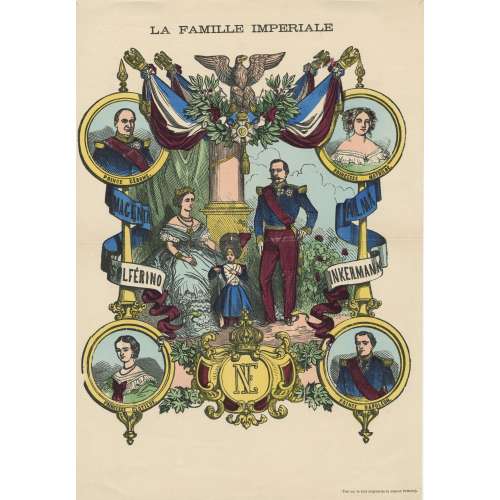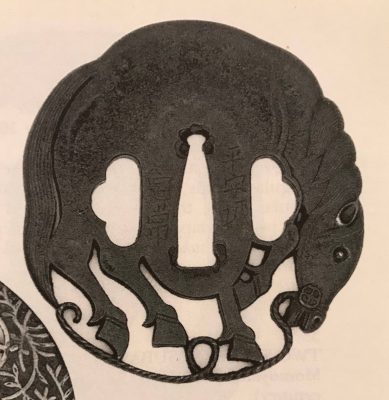-
 Description: 19th-century binding, 8vo,18.9 x 11.7 cm, in patterned quarter green shagreen over marbled boards, gilt elements and lettering to spine (reliure romantique), printed on laid paper, with tall "s", margins sprinkled blue. Title-page (red and black): L'ART | D'AIMER, | NOUVEAU POËME | EN SIX CHANTS, | Par Monsieur ***** Gouge de Cessières. | Edition fidéle & complette, enrichie de | Figures. | {vignette} | A LONDRES. | Aux dépens de la Compagnie. | = | M. DCC. L. || Includes: La Mort de Zulnï (pp. 175-190 ), Idée de l'Art d'aimer d'Ovide (pp. 191-244), and Lettre écrite à Monsieur *** de ******de l'Académie... (pp. 245-261). Collation: 8vo; a-b8, A-Q8 R3, lacking K2 (pp. 147/8); total 146 leaves (of 147) plus 8 engraved plates, unsigned, incl. frontispiece. Pagination: [i, ii] iii-xxxii, [1, 2] 3-261 [262 blank], lacking pp. 147/8 (K2), possibly containing Argument du chant VI; total 292 pages (of 294), ils. Catalogue raisonné: Cohen-DeRicci (under Ovid) 775, Lewine (under Ovid) 398. The artist and engravers of this edition are unknown. "Another edition, Londres (Paris), 1760, with frontispiece after Eisen by Martinet, and 6 plates after Martinet". Contributors: François-Étienne Gouge de Cessières (French, 1724 – 1782) – author. Ovid [Publius Ovidius Naso] (Roman, 43 B.C. – A.D. 17) – author. Aux dépens de la Compagnie (1685 – 1780) (Amsterdam) – publisher.
Description: 19th-century binding, 8vo,18.9 x 11.7 cm, in patterned quarter green shagreen over marbled boards, gilt elements and lettering to spine (reliure romantique), printed on laid paper, with tall "s", margins sprinkled blue. Title-page (red and black): L'ART | D'AIMER, | NOUVEAU POËME | EN SIX CHANTS, | Par Monsieur ***** Gouge de Cessières. | Edition fidéle & complette, enrichie de | Figures. | {vignette} | A LONDRES. | Aux dépens de la Compagnie. | = | M. DCC. L. || Includes: La Mort de Zulnï (pp. 175-190 ), Idée de l'Art d'aimer d'Ovide (pp. 191-244), and Lettre écrite à Monsieur *** de ******de l'Académie... (pp. 245-261). Collation: 8vo; a-b8, A-Q8 R3, lacking K2 (pp. 147/8); total 146 leaves (of 147) plus 8 engraved plates, unsigned, incl. frontispiece. Pagination: [i, ii] iii-xxxii, [1, 2] 3-261 [262 blank], lacking pp. 147/8 (K2), possibly containing Argument du chant VI; total 292 pages (of 294), ils. Catalogue raisonné: Cohen-DeRicci (under Ovid) 775, Lewine (under Ovid) 398. The artist and engravers of this edition are unknown. "Another edition, Londres (Paris), 1760, with frontispiece after Eisen by Martinet, and 6 plates after Martinet". Contributors: François-Étienne Gouge de Cessières (French, 1724 – 1782) – author. Ovid [Publius Ovidius Naso] (Roman, 43 B.C. – A.D. 17) – author. Aux dépens de la Compagnie (1685 – 1780) (Amsterdam) – publisher. -
 Hand-coloured woodcut on wove paper, 366 x 460 mm; black ink stamp “5057” to reverse. Caption cartoon in 2 tiers. Top: OUVERTURE DE 'EXPOSITION UNIVERSELLE DE 1855. CORTÈGE IMPÉRIAL. Captions top to bottom: Garde de Paris. — Les Cent Gardes. — Cuirassier. — Grenadiers. Middle: Voiture de sa Majesté Napoléon III. | Bottom: Grenadier. — Musique des Guides. — Piqueur de l’Empereur. — Gral Anglais — Généraux — Colonel de Cuirassiers | de la Garde — Généraux. Below left: Imprimerie Lith. de Pellerin, à Épinal; right: Propriété de l’Éditeur. Déposé. Jean Charles Pellerin (French, 1756 – 1836) – printer/publisher.
Hand-coloured woodcut on wove paper, 366 x 460 mm; black ink stamp “5057” to reverse. Caption cartoon in 2 tiers. Top: OUVERTURE DE 'EXPOSITION UNIVERSELLE DE 1855. CORTÈGE IMPÉRIAL. Captions top to bottom: Garde de Paris. — Les Cent Gardes. — Cuirassier. — Grenadiers. Middle: Voiture de sa Majesté Napoléon III. | Bottom: Grenadier. — Musique des Guides. — Piqueur de l’Empereur. — Gral Anglais — Généraux — Colonel de Cuirassiers | de la Garde — Généraux. Below left: Imprimerie Lith. de Pellerin, à Épinal; right: Propriété de l’Éditeur. Déposé. Jean Charles Pellerin (French, 1756 – 1836) – printer/publisher. -
 Hand-coloured lithography on wove paper, 275 x 385 mm; vertical centerfold, image in frame. On reverse: black ink stamp “5350”. Above the frame: "IMAGERIE NOUVELLE — MORT DU PRINCE LOUIS-EUGÈNE-NAPOLÉON. — ACTUALITÉS PL. 699". Under the frame: "L'ex-prince impérial, né le 16 Mars I856, était parti pour le Cap, à l'extrême sud de l'Afrique, pour faire son apprentissage de guerre, et combattre avec les Anglais, la tribu sauvage des Zoulous. L'une des dépêches reçues confirme sa mort dans les termes suivants: — Capetown, 3 Juin 1879. — Le prince Napoléon-Eugène a été tué à l'ennemi, avant-hier, 1er Juin 1879, Il était parti en reconnaissance, avec quelques officiers et une fable escorte, au-delà du Blood River. Il descendit de cheval ave ses compagnons, au milieu des hautes herbes, pour prendre un peu de repos. Les Zoulous, rampant selon leur coutume, s'approchèrent en grand nombre et entourèrent la petite troupe. On ne les vit que lorsqu' ils furent à trois ou quatre mètres du groupe. Aussitôt chacun court vers son cheval, et quelques-uns des Anglais parvinrent à s'échapper. Quant au prince, surpris et frappé à coups de zagaie, il resta sur la place avec deux soldats. Quand les Anglais sont revenus en force, ils ont retrouvé le cadavre du jeune fils de Napoléon III percé de dix-sept coups de zagaie et complétement dépouillé de ses vêtements et de ses armes". — "Typographie, Lithographie, Imagerie, Haguenthal, Éditeur à Pont-à-Mousson". Pencil ms: "1860-1880". Élie Haguenthal (French, 1822 – 1881) – publisher/printer.
Hand-coloured lithography on wove paper, 275 x 385 mm; vertical centerfold, image in frame. On reverse: black ink stamp “5350”. Above the frame: "IMAGERIE NOUVELLE — MORT DU PRINCE LOUIS-EUGÈNE-NAPOLÉON. — ACTUALITÉS PL. 699". Under the frame: "L'ex-prince impérial, né le 16 Mars I856, était parti pour le Cap, à l'extrême sud de l'Afrique, pour faire son apprentissage de guerre, et combattre avec les Anglais, la tribu sauvage des Zoulous. L'une des dépêches reçues confirme sa mort dans les termes suivants: — Capetown, 3 Juin 1879. — Le prince Napoléon-Eugène a été tué à l'ennemi, avant-hier, 1er Juin 1879, Il était parti en reconnaissance, avec quelques officiers et une fable escorte, au-delà du Blood River. Il descendit de cheval ave ses compagnons, au milieu des hautes herbes, pour prendre un peu de repos. Les Zoulous, rampant selon leur coutume, s'approchèrent en grand nombre et entourèrent la petite troupe. On ne les vit que lorsqu' ils furent à trois ou quatre mètres du groupe. Aussitôt chacun court vers son cheval, et quelques-uns des Anglais parvinrent à s'échapper. Quant au prince, surpris et frappé à coups de zagaie, il resta sur la place avec deux soldats. Quand les Anglais sont revenus en force, ils ont retrouvé le cadavre du jeune fils de Napoléon III percé de dix-sept coups de zagaie et complétement dépouillé de ses vêtements et de ses armes". — "Typographie, Lithographie, Imagerie, Haguenthal, Éditeur à Pont-à-Mousson". Pencil ms: "1860-1880". Élie Haguenthal (French, 1822 – 1881) – publisher/printer. -
 Iron tsuba of round form with a dense combination of symbols: slanting rays of light (shakoh) Christian motif (Jesuit's IHS symbol), also often described as "tokei" or "clock gear", wild goose in flight, bracken, and lozenges in openwork (sukashi). Copper sekigane. Edo period.
Iron tsuba of round form with a dense combination of symbols: slanting rays of light (shakoh) Christian motif (Jesuit's IHS symbol), also often described as "tokei" or "clock gear", wild goose in flight, bracken, and lozenges in openwork (sukashi). Copper sekigane. Edo period.Size: 76.0 x 72.6 x 6.2 mm
Unsigned.
For information regarding shakoh tsuba see article 'Kirishitan Ikenie Tsuba by Fred Geyer at Kokusai Tosogu Kai; The 2nd International Convention & Exhibition, October 18-23, 2006, pp. 84-91.
-
 Hand-coloured woodcut on laid paper, 422 x 294 mm; black ink stamp “5307” to reverse, centrefold. Top center: "LA FAMILLE IMPERIALE"; Bottom right: "(Tire sur le bois original de maison Pellerin)". Image: Napoléon III, Empress Eugenie, and Prince Imperial Louis-Napoléon as a child surrounded with four lettered medallions: “PRINCE GÉROME”, “PRINCESSE MATHILDE”, “PRINCESSE CLOTILDE”, and “PRINCE NAPOLÉON”; ribbons lettered: “MAGENTA”, SOLFERINO”, “ALMA”, and “INKERMANN” around heraldic spears; coat of arms with imperial monogram between Princesse Clotilde and Prince Napoléon. Publisher/printer: Jean Charles Pellerin (French, 1756 – 1836). Battle of Magenta : 4 June 1859, against the Austrians. Battle of Solferino : 24 June 1859, against the Austrians. Battle of the Alma : 20 September 1854 (Crimean War) Battle of Inkerman : 5 November 1854 (Crimean War) Characters: Napoleon III [Charles-Louis Napoléon Bonaparte] (French, 1808 – 1873) Eugénie de Montijo [L'impératrice Eugénie] (Spanish-French, 1826 – 1920) Napoléon, Prince Imperial (Napoléon Eugène Louis Jean Joseph Bonaparte] (French, 1856 – 1879) Napoléon-Jérôme Bonaparte [Prince Jérôme] (French, 1822 – 1891) Mathilde Bonaparte [Princess Mathilde] (French, 1820 – 1904) Marie-Clotilde de Savoie [Princesse Clotilde] (French, 1843 – 1911)
Hand-coloured woodcut on laid paper, 422 x 294 mm; black ink stamp “5307” to reverse, centrefold. Top center: "LA FAMILLE IMPERIALE"; Bottom right: "(Tire sur le bois original de maison Pellerin)". Image: Napoléon III, Empress Eugenie, and Prince Imperial Louis-Napoléon as a child surrounded with four lettered medallions: “PRINCE GÉROME”, “PRINCESSE MATHILDE”, “PRINCESSE CLOTILDE”, and “PRINCE NAPOLÉON”; ribbons lettered: “MAGENTA”, SOLFERINO”, “ALMA”, and “INKERMANN” around heraldic spears; coat of arms with imperial monogram between Princesse Clotilde and Prince Napoléon. Publisher/printer: Jean Charles Pellerin (French, 1756 – 1836). Battle of Magenta : 4 June 1859, against the Austrians. Battle of Solferino : 24 June 1859, against the Austrians. Battle of the Alma : 20 September 1854 (Crimean War) Battle of Inkerman : 5 November 1854 (Crimean War) Characters: Napoleon III [Charles-Louis Napoléon Bonaparte] (French, 1808 – 1873) Eugénie de Montijo [L'impératrice Eugénie] (Spanish-French, 1826 – 1920) Napoléon, Prince Imperial (Napoléon Eugène Louis Jean Joseph Bonaparte] (French, 1856 – 1879) Napoléon-Jérôme Bonaparte [Prince Jérôme] (French, 1822 – 1891) Mathilde Bonaparte [Princess Mathilde] (French, 1820 – 1904) Marie-Clotilde de Savoie [Princesse Clotilde] (French, 1843 – 1911) -

Iron tsuba pierced and carved (marubori-sukashi) with the 'horse in the round' design. Possibly, Bushū-Ito school, 19th century (ca. 1800). Kogai-hitsu-ana plugged with shakudō.
Size: 67.6 x 66.8 x 5.1 mm
Unsigned.
See:
-
- Robert E. Haynes. Study Collection of Japanese Sword Fittings. Nihon Art Publishers, 2010, p. 120: Iron plate carved and formed in the round as a tethered bull...Signed: Bushū jū Sadayasu saku.
- Robert E. Haynes. Masterpiece and highly important tsuba, etc... San Francisco, 1984 // Catalog #9.: Signed: Bushū jū Yoshifusa. Ca. 1800, H 6.7 cm, Th. 4.75 mm.
- The Hartman collection of Japanese metalwork. Christie's, 1976, p. 29, №59: Bushū type, 19th century. Reference to Takezawa, Nihon Toban Zuetsu №411 for a similar design signed Bushū Yoshifusa.
4. Japanese Sword Fittings from the R. B. Caldwell Collection. Sale LN4188 "HIGO". Sotheby's, 30th March 1994, p. 17, №24: An iron tsuba, by Heianjo Sadatsune, Edo period (18th century). In the form of a horse, standing with its head lowered and a rope halter attached to its bit and trailing beneath. Signed Heianjo Sadatsune, 7.3 cm. With NBTHK Tokubetsu kicho paper, dated Showa 49 (1974). GBP 600-700.
Hartman collection, №59.

The Caldwell Collection. Heianjo Sadatsune, Edo period (18th century).
-
-

Copper tsuba of slightly elongated round form carved in low relief (usuniku-bori, katakiri bori) with the design of a mythical creature: a horse, however, with divided hoofs, with anthropomorphic (human-like) face though with a vertically positioned third eye on the forehead, and a corn. Certain elements of the image accentuated with gold iroe. On the back: flowers and grasses carved in katakiribori technique. Shakudō fukurin.
Edo period.
Dimensions: 70.7 x 70.2 x 3.7 mm In a custom wooden box.


